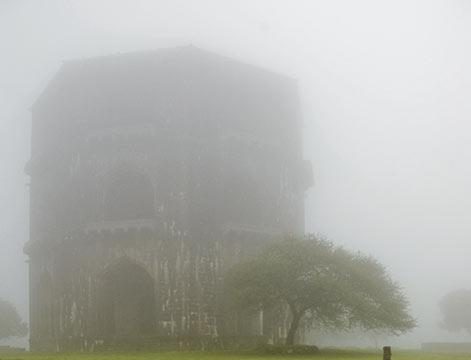The little town of Ahmednagar is a deceptively quiet place. But a peek at its hidden treasures reveals that everything about this town’s history speaks of a people who thought big. Really big. Like the Talikot Battle Memorial, a beautifully carved monument built by King Ahmed Nizam Shah. The warrior in whose honour this grand edifice was erected? Ghulam Ali — an elephant who distinguished himself in the war with the Vijayanagar Empire in 1565 AD. The medieval capital of the Nizam Shahi dynasty, Ahmednagar seems to have been really keen on pachyderms. Hatti Barav, a huge, ancient well with a series of picturesque steps cut in a pattern of neat geometric squares leading down to the water, was built so that elephants could be used to draw water from it.
Like many other historic towns, Ahmednagar too has its own museum. Except, its colonial connection is showcased in a museum of tanks! The Cavalry Tank Museum of the Armoured Corps Centre and School is the only one of its kind in Asia and there’s just one other such museum in the whole world. The museum’s collection includes a 1934-vintage armoured car Schmerer Panzersphah Wagen (8-RAD), complete with Nazi swastika, and a near-century-old World War I Sherman. You can also make the acquaintance of Big Willie, Matilda and Bahadur, terms of endearment for a First World War Mark I tank, a British A9 tank and a Centurion tank, respectively. Apart from a mine-detonating tank, and tanks like Chaffee, Walker-Bulldog and Patton, captured from the enemy forces of Pakistan in the war of 1965, there’s also a tank that scaled incredible heights — the 1971 Stuart, taken to a record 12,000ft at the Zojila Pass in 1948 by the Indian Army’s 7th Cavalry.The massive Ahmednagar Fort was once considered the second most impregnable fort in India. If you’re lucky, your visit will coincide with one of the two days of the year that it is open to the public — Republic Day and Independence Day. A profound sense of history radiates from the fort’s sheer stone face, stretching for kilometres on end. A part of the fort has been converted into a museum and is open to the public year-round. Pandit Nehru wrote his epic Discovery of India when confined here.
At the Museum of Ahmednagar, another big attraction is a 66m-long horoscope dating back to 1775. Not to mention 50,000 historical documents, 12,000 manuscripts, over 8,000 coins, 400-odd historical paintings and a whole host of other artefacts on display. Ahmednagar’s colonial legacy shines in a London-printed map of India, dating to 1816. The museum is open all day (10am to 5pm daily, except on Thursdays). In this town, even tiny things add up to make up an impressive whole — witness Damdi Masjid, a grand stone mosque built from contributions of damdis, ancient copper coins which were the smallest denomination of currency at the time. Your last sightseeing stop should be the eerily silent tomb of Salabat Khan. Here, at the highest vantage point in Ahmednagar, a fabulous view of rolling countryside lies at your feet.
With so much to see, it’s easy to work up a huge appetite too! The experience of warm hospitality begins on the drive down from Pune on the Pune-Ahmednagar state highway. Halfway down this road, the village of Saradwadi is a popular stopover, with people driving down from Mumbai just to sample its justly famous vada pav. Ahmednagar itself is a foodie’s paradise. The gulab jamuns and jalebis from Bansi Maharaj alone make this town worth a second trip. And if you’re visiting during custard apple season, be sure to visit Sweet Home in Savedi. Their fresh sitaphal ice cream, available only while the fruit is in season (August to December), is a must-have.
Ahmednagar offers history and hospitality in an arid, ruggedly stunning landscape. A trip here is surreal, beautiful and altogether unexpected.
Ahmednagar is 120km from Pune (less than 4hrs by car); a cab from Pune airport will cost Rs 1,500-2,000 for four people.




